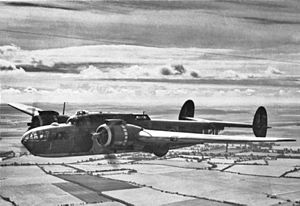| Albemarle | |
|---|---|
 Armstrong Whitworth Albemarle Mark I series 2 (P1475) of 511 Squadron c. 1943 | |
| General information | |
| Type | Transport, glider tug |
| National origin | United Kingdom |
| Manufacturer | Armstrong Whitworth Aircraft |
| Built by | A W Hawksley Ltd |
| Primary users | Royal Air Force (RAF) |
| Number built | 602[1] |
| History | |
| Manufactured | 1941–1944[2] |
| Introduction date | January 1943 |
| First flight | 20 March 1940 |
| Retired | February 1946 |
The Armstrong Whitworth A.W.41 Albemarle was a twin-engine transport aircraft developed by the British aircraft manufacturer Armstrong Whitworth and primarily produced by A.W. Hawksley Ltd, a subsidiary of the Gloster Aircraft Company. It was one of many aircraft which entered service with the Royal Air Force (RAF) during the Second World War.
The Albemarle had been originally designed as a medium bomber to fulfil Specification B.9/38 for an aircraft that could be built of wood and metal without using any light alloys; however, military planners decided to deemphasise the bomber role in favour of aerial reconnaissance and transport missions, leading to the aircraft being extensively redesigned mid-development. Performing its maiden flight on 20 March 1940, its entry to service was delayed by the redesign effort, thus the first RAF squadron to operate the Albemarle, No. 295 at RAF Harwell, did not receive the type in quantity until January 1943. As superior bombers, such as the Vickers Wellington, were already in use in quantity, all plans for using the Albemarle as a bomber were abandoned.
Instead, the Albemarle was used by RAF squadrons primarily for general and special transport duties, paratroop transport and glider towing, in addition to other secondary duties. Albemarle squadrons participated in Normandy landings and the assault on Arnhem during Operation Market Garden. While the Albemarle remained in service throughout the conflict, the final examples in RAF service were withdrawn less than a year after the war's end. During October 1942, the Soviet Air Force also opted to order 200 aircraft; of these, only a handful of Albemarles were delivered to the Soviets prior to the Soviet government deciding to suspend deliveries in May 1943, and later cancelling the order in favour of procuring the American Douglas C-47 Skytrain instead.